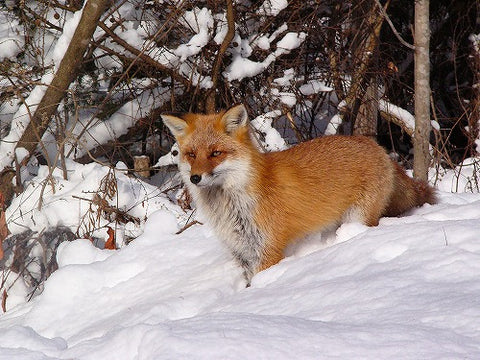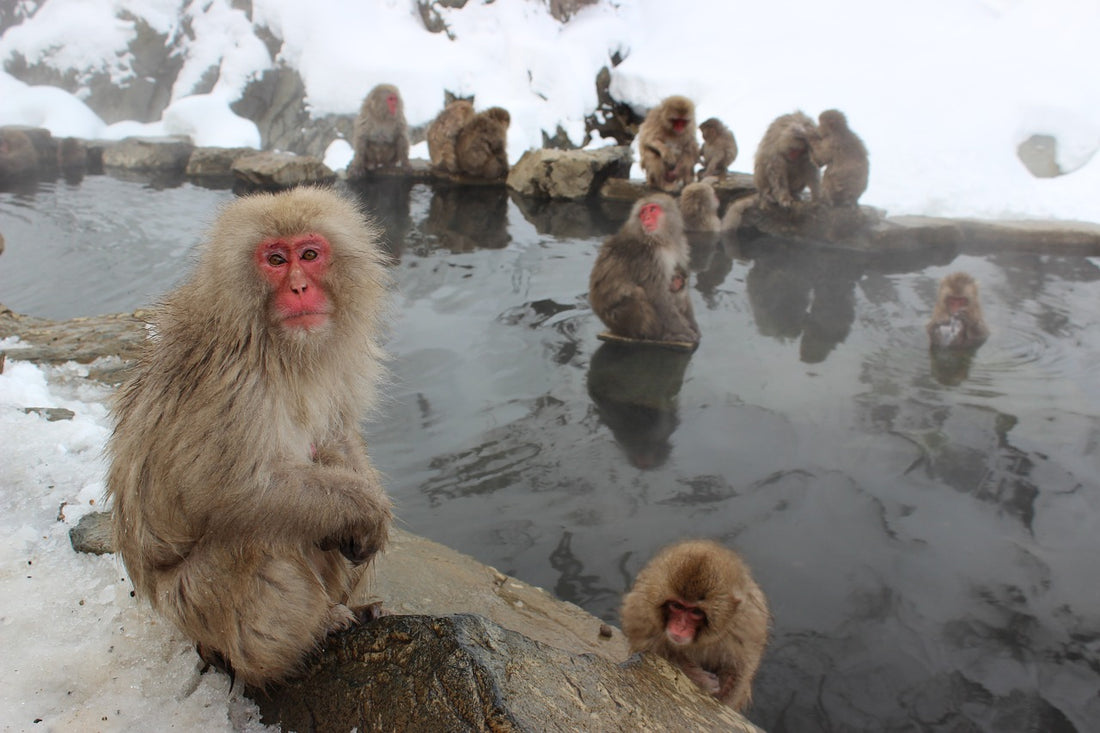Top 10 Japanese animals
It's no secret that Japan has been a country of interest for a long time now. The people, culture, and history have captivated the imaginations of many generations, but have you ever thought about what animals live in Japan? What creatures could have been responsible for the spectacular beings featured in Japanese mythology? Or even the bizarre animals that are seen in today's popular anime, with Pokémon's Pikachu being styled after a creature named the pika.
Northern pika - ochotona hyperborea

- Location: North-eastern Eurasia - Chukotka, Kamchatka, Sakhalin and Hokkaido Island in mountain ranges
- Size: 13-19cm and a 5-12mm long tail
- Weight: circa 150g
The northern pika is a short-legged mammal with rounded ears and an extremely short tail, unlike that of Pokémon's interpretation that has a long zig-zag tail and pointed ears.
Located in mountainous areas of Japan, the pika occupies cavities between rocks, and feeds on the leaves and stems of many different plant species, even mushrooms and mosses, which it gathers and stores for the winter months. Pika, however, doesn't hibernate.
Pika isn't just exclusive to Japan; it can also be found throughout Asia and even in North America!
Although the pika may look like a rodent, it belongs to the same group as rabbits and hares and is the smallest representative of the group.
Giant Japanese salamander - andrias japonicus

- Location: Rivers of northern Kyushu islands and western Honshu
- Size: 1.5m
- Weight: 25kg
The giant salamander is the second largest salamander in the world! Growing to an impressive length of 1.5 meters, this weird looking river monster has an elongated body, broad tail and wrinkled skin of varying patterns. When aggravated or stressed these salamanders secrete a sticky, white substance which is toxic to predators and is said to smell like Japanese peppers.
The giant salamander lives on a diet of mainly fish, worms and insects. One interesting fact about the salamander is that it has one large lung which it doesn't use for breathing, the lung is instead used as a floatation device. The giant salamander breathes through its skin, which acts as a respiratory surface releasing carbon dioxide and taking in oxygen.
Tanuki - Japanese raccoon dog - nyctereutes procyonoides viverrinus

- Location: Forests, wetlands and urban areas of Japan
- Size: 18 to 20 inches in length
- Weight: fluctuates depending on seasons. In spring they weigh 3kg, whereas in August and September around 6.5kg
Often portrayed in Japanese mythology as a fox-like creature with a large belly, massive scrotum and a bottle of sake. The Tanuki has a reputation of mischievous shape-shifters that took human form by haunting and possessing people. That's why they were often seen as omens of misfortune. However, on the other hand, Tanuki was also associated with good luck because their skin was once used to carry gold - which is why they are depicted with huge scrotum.
Tanuki is omnivorous, non-confrontational animals that live in packs and hibernate during winter instead of competing for scarce resources.
Despite their appearance the Tanuki aren't closely related to the raccoon, they belong to the canid family and resemble what the ancestors of modern canines would have looked like. Its closest relative is a fox.
Japanese Giant Hornet - vespa mandarinia

- Location: High altitudes of mountainous areas of Japan
- Size: Between 2.5 and 4.5 cm with a wing span of around 4 – 6 cm
Giant hornets are the largest species of hornet in the world. With some queens known to grow to outstanding lengths of 5 cm with a wingspan of around 7cm, which for a hornet is enormous! With a top speed of up to 25mph, you wouldn't want one of these flying towards you!
Unlike a bee, giant hornets don't have barbed stings, which means that once it stings you, it's going to keep coming back for more. The venom is a complex concoction of eight different chemicals that make the hornets sting extra nasty and can even melt your flesh.
The giant hornet is most commonly called a giant sparrow bee in Japan and is well known for its aggressive behaviour. Their preferred food is honey bee larvae. It is said that the hornets can decimate up to 40 bees every half minute.
Iizuna - Japanese Least Weasel - mustela itatsi

- Location: northern Hokkaido
- Size: 15-22cm long
- Weight: 36 to 250g (1.3 to 8.8oz)
The iizuna is a subspecies of a weasel, which can be found on Hokkaido Island in Japan, as well as Siberia and Scandinavia. You can guess that least weasels much prefer cold climates. They can change their fur's colour according to surrounding weather conditions. Iizuna's coat colour is a defence mechanism, it is typically brown, but turns white to disguise itself amongst the snow.
The long body is ideally suited for penetrating their victims' dens. However, the proportions of the legs to the long body mean that running between the trees takes a lot of energy.
Ezo Fukurou - Hokkaido owl - strix uralensis

- Location: Hokkaido
- Size: 50 to 61cm, wingspan from 110 to 134cm
- Weight: 500–730g (1.10–1.61lb) for males and 720–1,300g (1.59–2.87lb) for females
Hokkaido owl is a subspecies of Ural owl family, native to Hokkaido prefecture in Japan. This nocturnal creature is one of only ten owl species in the area. Its Japanese name translates to Hokkaido Owl – Ezo derives from the old name of the island, and fukurou simply means an owl. The etymology of the word fukurou is quite interesting though, the symbol for fuku 福 stands for "luck," therefore owls are considered a lucky charm in Japan. It is also said that they protect against suffering and hardships when written as 不苦労 - fu for "no" and kurou for "hardship"/"suffering."
These small owls feed mainly on little mammals.
Hokkaido owls can be seen around all year round and are mainly recognised for their characteristic call.
Ezo naki usagi - Hokkaido Crying Rabbit

- Location: Hokkaido Island
- Size: 12-19cm
Japan is home to an astonishing number of rabbits – there even is a Bunny Island (Ōkunoshima) that became famous back in 2014 when a video of a woman being chased by a hoard of rabbits went viral. There is quite a number of various rabbit species that can't be seen anywhere else in the world. Example being this adorable crying rabbit deriving from the pika family. Being a rabbit's distant relative, it looks more like a big hamster with their small rounded ears, short limbs.
Crying rabbit's lifespan is very short – only up to 3 years. They're sociable animals that live in small family groups. They are very territorial, and they can warn each other in case of danger.
Its name comes from its distinctive high-pitched half-whistle call, which sounds as if it's crying. You can listen yourself by checking out this short video.
Shima enaga - Long-tailed Tit

- Location: Hokkaido and areas south of it
- Size: 13–15 cm including the tail
This adorable tiny, puffball-looking bird is native to Hokkaido area, and that's the only place in the world where you can encounter it. It is commonly found in forests from lowlands to the mountains. What distinguishes the Shima enaga to their western cousins is the fact that, just like the least weasels, they use camouflage to survive in Hokkaido's nature.
Adult long-tailed tits are entirely white with dark flight feathers, while the adolescents additionally have dark "eyebrows."
These little birds live in herds. Interestingly, they can hang on tree branches upside-down. They mainly live off of soft foods such as insects, their eggs, and larvae, as their beaks are too little and weak to break through hard surfaces.
Kita kitsune - Hokkaido Red Fox

- Location: Hokkaido, Sakhalin and surrounding Japanese islands
- Size: 46 to 86cm (18 to 33.75 inches), with a tail length of 30.5 to 55cm (12 to 21 inches)
- Weight: 3-11kg (6.5-24 pounds)
Ezo red foxes live widely from the flatland to the mountain belts in Hokkaido. They often occur in cities, town, and villages, and in various rural districts.
Red foxes are mainly carnivorous - they mostly eat rats, mountain hares, birds, and insects; but as well as that, they also eat fruits and nuts in autumn. Therefore, they are classified as omnivores.
In Honshu, foxes tend to be shy creatures only seen around at night time, however in Hokkaido, they are curious and often approach anyone in their surroundings
Fox's fur varies in colours, and you can encounter brightly-coloured red foxes, but also those of white and grey coating. Their bushy tails are crucial to survive winter months when they curl them around themselves to insulate from the cold.
The fox is a popular subject in the Japanese folklore and mythology. They're often are associated with shapeshifting. in old tales foxes are portrayed taking the form of humans, particularly women. The Hokkaido red fox is highly respected in Japan due to its magical powers. It's considered to be the messenger of the Japanese goddess Inari, who was responsible for e.g., the rice harvest, and the fate of blacksmiths and merchants.
Red-crowned Cranes - grus japonensis

- Location: Hokkaido
- Size: 150cm (5 ft) with wingspan up to 250cm
- Weight: 7,000 - 10,000g (17-22lbs)
Japanese cranes, also known as red-crowned cranes, are the heaviest and the largest cranes species in the world. Their weight can reach up to 25 pounds!
They are named after a red patch of skin on the crown, which becomes brighter during mating season. Their feathers are white thoroughly, with black flight feathers on the wings. Males have black cheeks, throat, and neck, while females are grey in these areas.
They play a unique role in Japanese mythology and are believed to represent longevity, fidelity, good luck, and love.
Japanese cranes are famous for their distinctive ritual dance which they perform in unison during their mating season to strengthen their lifelong bond.
Sources
- http://www.arkive.org/japanese-giant-salamander/andrias-japonicus/
- http://www.japannatureguides.com/japan-nature-guides-reptiles-and-amphibi/
- http://mentalfloss.com/article/70797/12-surprising-facts-about-raccoon-dogs
- http://animals.mom.me/tanuki-3781.html
- https://a-z-animals.com/animals/asian-giant-hornet/
- http://www.okhotskbirds.com/bg/uralowl.html
- https://news.nationalgeographic.com/2017/12/rabbit-island-japan-overrun-tourism-spd/
- https://www.japantimes.co.jp/life/2010/08/15/environment/relics-of-ice-age-japan/#.Wjr2pt9l_IV
- http://www.okhotskbirds.com/bg/longtailedtit.html
- https://www.japanvisitor.com/japan-nature/red-fox
- http://www.coyotes.org/kitsune/
- http://www.arkive.org/japanese-crane/grus-japonensis/
- https://www.savingcranes.org/species-field-guide/red-crowned-crane/

